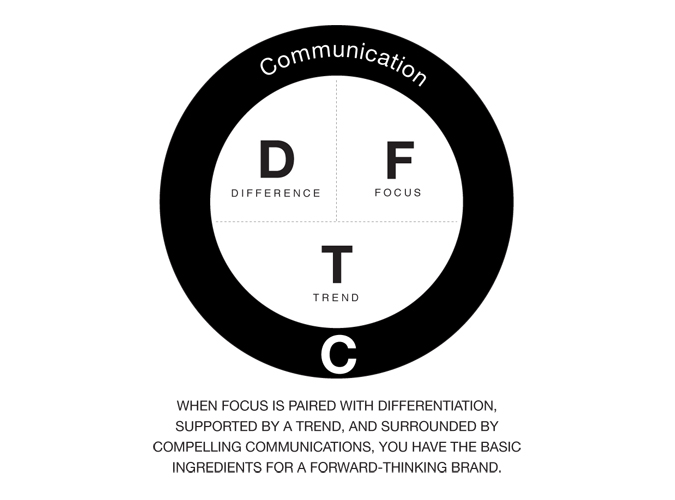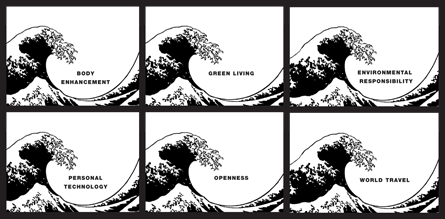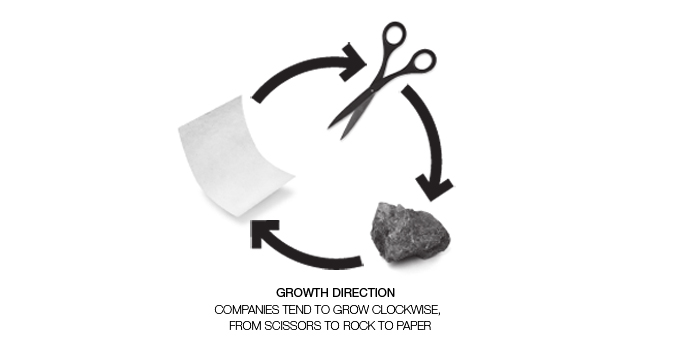“In a world of extreme clutter you need more than differentiation. You need RADICAL differentiation. The new rule: When everyone zigs, zag.”
That, in a nutshell, is what Zag: The #1 Strategy of High Performance Brands is all about.
Written and designed by Marty Neumeier from Liquid Agency, Zag is pretty short (you can probably finish the book in half a day or less) but packed with lots of punch. The book focuses on how organisations can develop strong and differentiated brands in an increasingly competitive and crowded communication and marketing landscape.
With differentiation at its core, Zag distilled in simplified form the wisdom of thought leaders like Jack Trout, David A. Aaker, and Al Ries as well as books like Blue Ocean Strategy. The slim volume also presented the author’s own view on marketing and branding.
Focus, Difference, Trend and Communication
At its core, Zag has a brand marketing model with four elements – Focus, Difference, Trend and Communication – which can be represented as follows:

Courtesy of Liquid Agency
To capitalise on all four elements, Neumeier guides us through 17 checkpoints which we could use as a gauge of how well developed and differentiated our brand could be.
These are namely as follows.
#1 Origin
Who are you? Where do you have the most credibility?
#2 Purpose
What do you do (ie what is your purpose in 12 words or less)?
#3 Vision
What’s your brand vision like? Paint a vivid picture of your future, test and refine it.
#4 Riding Waves
What current or future wave are you riding? List the trends that will power your success, and study each carefully to ensure that they match your business.
Some examples of waves include body enhancements (eg cosmetic surgery and tattoos), green living, environmental responsibility, personal technology and others. You can see them highlighted below:

Courtesy of Liquid Agency
#5 Your brandscape
Who shares the brandscape? Who are your competitors and how do they rank?
How can you be number one or two (aka the Jack Welch way) in your market?
#6 The only ___ that ____
What makes you the one and “only” player able to fulfill the promise or deliver that experience?
Complete the sentence: Our brand is the only ____ that ____.
#7 Add or subtract
What should you add or subtract? If in doubt, be brutal and err on the side of sacrifice. Less is more
#8 Find brand loyalists
Who loves you?
Determine who makes up your brand community. Engage the participants in this community. Find ways for them to can contribute and benefit your brand.
#9 Identify enemy
Who’s your brand’s enemy? Which competitor can you paint as the bad guy while you’re the hero?
#10 The name game
What do they call you?
Choose a name that is different, brief, appropriate, easy to spell and pronounce, used as a URL, suitable for “brandplay,” and legally defensible.
#11 Truelines and taglines
How do you explain yourself? What are your truelines (that tells why your brand is compelling) and taglines (that can be used with customers)?
#12 Spreading the word
How do you spread the word? How can you unpack your name, trueline and tagline, enroll brand advocates and compete at touchpoints where you can win?
#13 Engage to win
How do people engage with you? Which touchpoints let you compete in white space?
How can you map your value proposition against customer touchpoints where you can win?
#14 Map customer experience
What do your customer’s experience? Map your customer journey from non-awareness to full enrollment and beyond.
#15 Earn loyalty
How do you earn their loyalty?
Be loyal to your customers, ditch discounts that can result in “disloyalty” and give loyal customers tools to refer new ones.
#16 Extend brand success
How do you extend your success? Choose between a house of brands and a branded house, and add extensions that reinforce the brand’s meaning.
#17 Protect brand portfolio
How do you protect your portfolio? Avoid the C-Sickness – Contagion, Confusion, Contradiction and Complexity.
Way to Renew Your Zag
Beyond the 17 points, Neumeier also introduced a rather novel way to “Renew Your Zag” based on that old kiddy game called Scissors, Paper, Rock!
The game is cleverly used an analogy for companies at different stages:
- Scissors for start-ups with only one brand that is razor sharp, punching holes in large “paper” companies;
- Rock for medium-sized organisations with momentum that can damage “scissor” companies; and
- Paper for large companies that can smother “rock” companies.
Courtesy of Liquid Agency
In other words, focus beats size, size beats momentum, and momentum beats focus.
Are You Ready to Zag?
In summary, Zag is a pretty compelling read and a great trigger of ideas.
What I especially like about it is that the company itself has a blog where you’re encouraged to “steal ideas.”
In an age where companies are trying to impose more piracy protection through acts like SOPA (Stop Online Piracy Act), that is certainly a breath of fresh air!
After all, there is an abundance of ideas available out on the Internet – most of them free – and the challenge lies more in implementing them successful than in generating tonnes of ideas.



I recently came across your blog and have been reading along. i must say this is really a good read for me.
http://www.n8fan.net